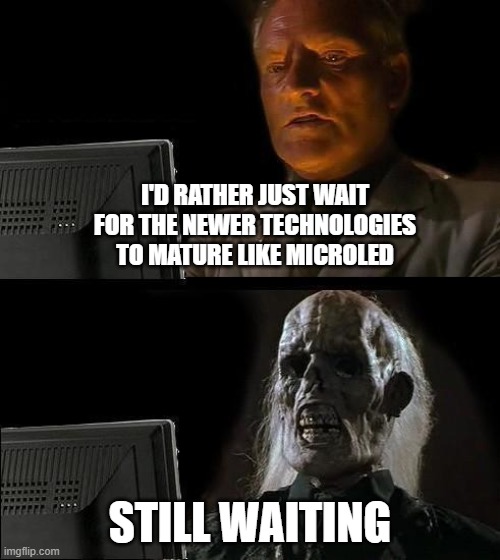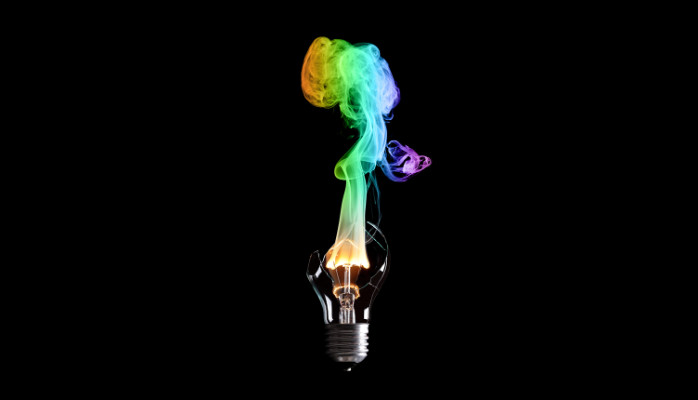BluRayHiDef
Banned
Does anyone think that OLED TVs are overrated? I understand that they have an infinite contrast ratio due to each of their pixels producing their own light and therefore being able to appear as a particular color or being able to completely shut off independently of neighboring pixels. I also understand that they have the best response times, maintain their contrast ratio and brightness levels at all viewing angles, and have very thin panels due to their lack of backlights and other components.
However, they have two major drawbacks, one of which nullifies all of their advantages: they're prone to burn-in and they don't get nearly as bright as LED LCD TVs.
I'm aware that the latest OLEDs have pixel-refresh mechanisms that minimize the possibility of burn-in to a significant degree; however, despite how effective these mechanisms are, they're not perfect and therefore the risk of burn-in still exists. Having said this, burn-in is not a drawback that would deter me from getting an OLED TV if there were not the second drawback: the low brightness levels.
OLED is an acronym for Organic Light Emitting Diode, which means that an OLED TV's sources of light are organic and therefore degrade much faster than the LEDs of LCD TVs, typically due to wear and tear and exposure to ambient oxygen and moisture. To maximize their lifespan, the maximum level of brightness at which they're programmed to operate is only a fraction of their natural maximum; this enables them to last for about ten years.
However, this maximum level of brightness is only 800 nits or so; for example, the LG CX, which is the most premium OLED TV released by LG this year, has a peak brightness of 813 nits, which it can reach when displaying a highlight that comprises 10% of its screen space. On the other hand, TCL's flagship TV of 2019, the Q825, can attain a brightness level of a whopping 1,822 nits when displaying a highlight that comprises 10% of its screen space; however, it can get even brighter when displaying a highlight that comprises 25% of its screen space, reaching 1,884 nits.
My current TV, which is a TCL 55R617 - an LED LCD TV, is a budget TV and can attain a peak brightness of 1,009 nits when displaying a highlight that comprises 10% of its screen space. Furthermore, it can attain an even higher level when displaying a highlight that comprises 25% of its screen space: 1,173 nits. Due to being a budget TV, it cost me only $707.65 (including tax and shipping) when I bought it from Amazon back in June of 2018. On the other hand, the LG CX costs $1,600 on Amazon before tax and shipping costs are calculated.
Considering the low maximum levels of brightness that OLED TVs possess, do you think that they're overrated? The true black level, which they can produce, is incredible; however, they're conversely low maximum levels of brightness render them unsuitable for use during daytime, when ambient light is shining through uncovered windows or even only through the spaces of window blinds.
I reckon that the increasing miniaturization of LEDs will render OLED obsolete within the next five years or less; micro LEDs will be able to produce levels of brighness that are even higher than 1,844 nits while being small enough to independently turn off and therefore produce true black for very small shadows, the space between celestial bodies in outer space, and black objects.
However, they have two major drawbacks, one of which nullifies all of their advantages: they're prone to burn-in and they don't get nearly as bright as LED LCD TVs.
I'm aware that the latest OLEDs have pixel-refresh mechanisms that minimize the possibility of burn-in to a significant degree; however, despite how effective these mechanisms are, they're not perfect and therefore the risk of burn-in still exists. Having said this, burn-in is not a drawback that would deter me from getting an OLED TV if there were not the second drawback: the low brightness levels.
OLED is an acronym for Organic Light Emitting Diode, which means that an OLED TV's sources of light are organic and therefore degrade much faster than the LEDs of LCD TVs, typically due to wear and tear and exposure to ambient oxygen and moisture. To maximize their lifespan, the maximum level of brightness at which they're programmed to operate is only a fraction of their natural maximum; this enables them to last for about ten years.
However, this maximum level of brightness is only 800 nits or so; for example, the LG CX, which is the most premium OLED TV released by LG this year, has a peak brightness of 813 nits, which it can reach when displaying a highlight that comprises 10% of its screen space. On the other hand, TCL's flagship TV of 2019, the Q825, can attain a brightness level of a whopping 1,822 nits when displaying a highlight that comprises 10% of its screen space; however, it can get even brighter when displaying a highlight that comprises 25% of its screen space, reaching 1,884 nits.
My current TV, which is a TCL 55R617 - an LED LCD TV, is a budget TV and can attain a peak brightness of 1,009 nits when displaying a highlight that comprises 10% of its screen space. Furthermore, it can attain an even higher level when displaying a highlight that comprises 25% of its screen space: 1,173 nits. Due to being a budget TV, it cost me only $707.65 (including tax and shipping) when I bought it from Amazon back in June of 2018. On the other hand, the LG CX costs $1,600 on Amazon before tax and shipping costs are calculated.
Considering the low maximum levels of brightness that OLED TVs possess, do you think that they're overrated? The true black level, which they can produce, is incredible; however, they're conversely low maximum levels of brightness render them unsuitable for use during daytime, when ambient light is shining through uncovered windows or even only through the spaces of window blinds.
I reckon that the increasing miniaturization of LEDs will render OLED obsolete within the next five years or less; micro LEDs will be able to produce levels of brighness that are even higher than 1,844 nits while being small enough to independently turn off and therefore produce true black for very small shadows, the space between celestial bodies in outer space, and black objects.





:max_bytes(150000):strip_icc()/family-watching-movie-at-home-on-projection-screen-103810540-5be2321dc9e77c00512a6057.jpg)